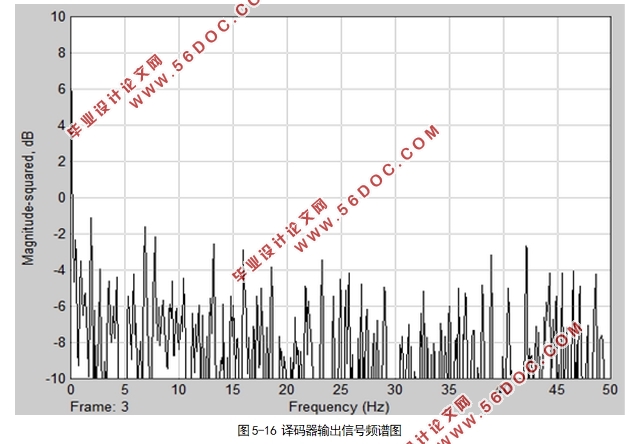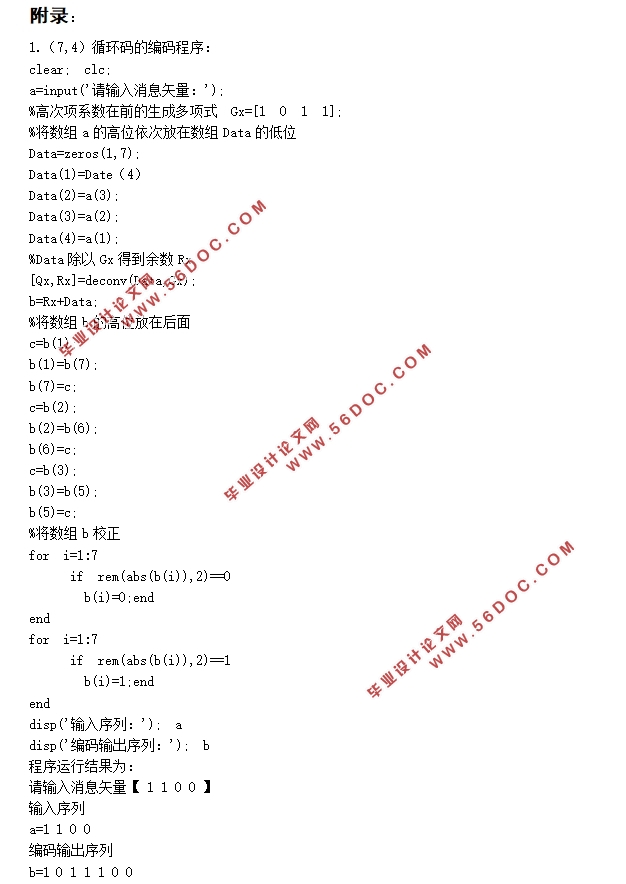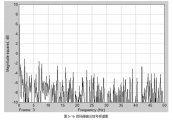基于MATLAB循环码编译码仿真
来源:56doc.com 资料编号:5D21233 资料等级:★★★★★ %E8%B5%84%E6%96%99%E7%BC%96%E5%8F%B7%EF%BC%9A5D21233
资料以网页介绍的为准,下载后不会有水印.资料仅供学习参考之用. 密 保 惠 帮助
资料介绍
基于MATLAB循环码编译码仿真(论文11000字)
摘要:在具体了解循环码的编码理论的基础上,使用 M ATLA B 软件设计了循环码编译码器。 通过 M ATLAB 软件实现循环码的编译码 ,通过SIMULINK软件使编译码器的仿真结果可视化 。本篇论文选取了(7,4)循环码为例,基于循环码的基本原理进行了系统的分析和解读,对(7.4)循环码提出了基于MATLAB的系统的仿真方案。仿真结果表明,循环码性能良好,可以通过较简单的编码和解码装置,对随机误差和突发错误进行校正,并具有较强的误差检测,并进行纠错能力。通过循环码特有的代数性质,对我们在构造编码的时候达到系统需要的纠正错误能力有很大帮助。
关键词:MATLAB,循环码,编译码,仿真。
Simulation of the Cyclic Code Generator Based on MATLAB
Qian Yifan
Electronic and Information Engineering, NUIST,Nanjing 210044,China
Abstract: The linear cyclic code generator was designed by the MATLAB software based on coding theory of the linear cyclic code.The generator accomplished outputs the cyclic code encoding results and wave forms through the MATLAB software,and realized the encoding visualization of cyclic code generator.Based on analyzing the theory of the encoding and decoding of cyclic code,this paper showed the schemes of encoding and decoding of (7,4) cyclic code by the software and based on MATLAB.The simulation results showed it's ability to review and error correction.Coding and decoding equipment is not complicated and there performance is better. They not only can correct random errors ,but also can be easy to implement Cyclic code , it is easy to use feedback shift registers with the hardware. Cyclic code has many special algebraic properties, these properties contribute to the error correction ability of the system .
Keywords : MATLAB;Linear cyclic code;Generator ; Encoding; Simulink.


目 录
第一章 绪论 1
第二章 课题介绍 3
2.1 纠错码 3
2.2 循环码 3
2.3 matlab的介绍 3
2.4 SIMULINK仿真的介绍 4
2.5 循环码的发展前景 4
第三章 循环码的设计原理 6
3.1 循环码的循环性 6
3.2 循环码多项式表示 6
3.3 循环码的生成多项式 7
3.4 循环码的生成矩阵和一致校验矩阵 8
3.5 循环码检错与纠错能力 9
第四章 循环码编码和译码原理 10
4.1 循环码的编码原理 10
4.2 循环码的译码原理 10
第五章 实现程序和仿真结果分析 14
5.1 循环码基于MATLAB的编译码 14
5.2 SIMULINK仿真 16
5.2.1 各模块参数设置 17
5.2.2 仿真波形 18
5.3 仿真分析 22
第六章 总结 24
参考文献 25
致谢 26
附录 27
|





